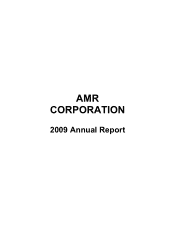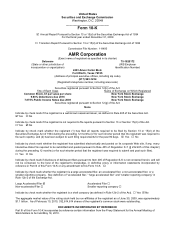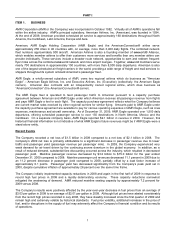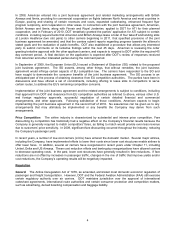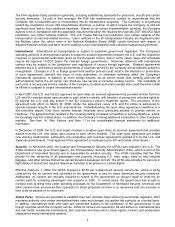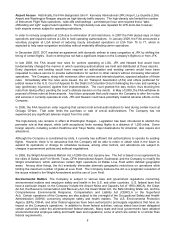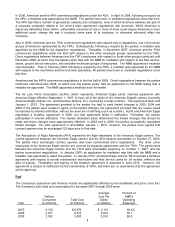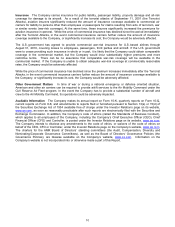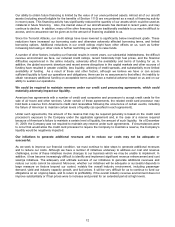American Airlines 2009 Annual Report Download - page 5
Download and view the complete annual report
Please find page 5 of the 2009 American Airlines annual report below. You can navigate through the pages in the report by either clicking on the pages listed below, or by using the keyword search tool below to find specific information within the annual report.
2
In addition, the Company’s 2009 operating results were negatively impacted by a net amount of $107 million in
special items, restructuring charges and a non-cash tax item. Special items of $184 million include the impairment
of certain route and slot authorities, primarily in Latin America, and losses on certain sale leaseback transactions.
Restructuring charges for 2009 were $171 million and related to announced capacity reductions, including the
grounding of the Airbus A300 fleet and the impairment of certain Embraer RJ-135 aircraft. Also included in 2009
results is a $248 million non-cash tax benefit resulting from the allocation of the tax expense to other
comprehensive income items recognized during 2009. Impacting comparative results, the Company incurred
restructuring charges of $1.2 billion in 2008 mostly related to impairment charges on certain aircraft fleets
associated with 2008 capacity reductions.
In reaction to the challenges of very weak demand and high and volatile fuel prices, the Company initiated a
series of actions intended to better position it to meet the industry’s economic challenges while continuing to build
on its strategy for long term success, including execution of its fleet renewal and replacement plan, initiatives to
improve dependability and on-time performance, and a continued emphasis on a range of service charges
introduced in 2008 to generate additional revenue.
In 2009, the Company raised a total of $4.3 billion in cash through financing transactions, secured financing
commitments covering all aircraft on firm order scheduled to be delivered to the Company in 2010 and 2011.
announced plans to focus its network by reallocating capacity to primary markets in Dallas/Fort Worth, Chicago,
Miami, New York and Los Angeles, and announced plans to enhance its fleet to better serve customers.
See Notes 4, 5, 6 and 13 to the consolidated financial statements for a detailed description of these financing
transactions and other committed financing of future aircraft deliveries.
In February 2010, American and JAL announced the decision to strengthen their relationship. The carriers, both
members of the oneworld alliance, jointly applied to the Department of Transportation (DOT) for antitrust
immunity (ATI) on certain routes, and jointly notified the Ministry of Land Infrastructure, Transport and Tourism of
Japan (MLIT) of the proposed cooperation. The Company believes this application will meet DOT’s pro-consumer
and pro-competition criteria for granting ATI. As a part of the application, American and JAL entered into a joint
business agreement which will enhance their scope of cooperation on routes between North America and Asia,
through adjustments to their respective networks, flight schedules, and other business activities. This, in turn, will
allow both carriers to better complement each other’s operations and to develop and offer competitive products
and quality service to their customers. The joint business agreement is subject to ATI approval and certain other
conditions. See Item 7 ―Management’s Discussion and Analysis of Financial Condition and Results of
Operations‖ for additional information on the JAL joint business application.
Implementation of the joint business agreement is subject to U.S. and foreign regulatory authorization, successful
negotiation of certain detailed financial and commercial arrangements, and other approvals. No assurances can
be given as to any arrangements that may ultimately be implemented or any benefits that the Company may
derive from such arrangements.
The Company’s ability to become profitable and its ability to continue to fund its obligations on an ongoing basis
will depend on a number of factors, many of which are largely beyond the Company’s control. Certain risk factors
that affect the Company’s business and financial results are discussed in the Risk Factors listed in Item 1A. In
order to remain competitive and to improve its financial condition, the Company must continue to take steps to
generate additional revenues and to reduce its costs. It has become increasingly difficult to identify and
implement significant revenue enhancement and cost savings initiatives. The adequacy and ultimate success of
the Company’s initiatives to generate additional revenues and reduce costs cannot be assured. Moreover,
whether the Company’s initiatives will be adequate or successful depends in large measure on factors beyond its
control, notably the overall industry environment, including passenger demand, yield and industry capacity
growth, and fuel prices. It will be very difficult for the Company to continue to fund its obligations on an ongoing
basis and to return to profitability if the overall industry revenue environment does not improve substantially or if
fuel prices were to increase and persist for an extended period at high levels.
Competition
Domestic Air Transportation The domestic airline industry is fiercely competitive. Currently, any United States
(U.S.) air carrier deemed fit by DOT is free to operate scheduled passenger service between any two points within
the U.S. and its possessions. Most major air carriers have developed hub-and-spoke systems and schedule
patterns in an effort to maximize the revenue potential of their service. American operates in five primary markets:
Dallas/Fort Worth (DFW), Chicago O'Hare, Miami, New York City and Los Angeles.

